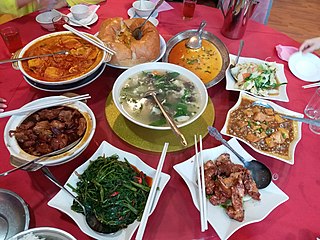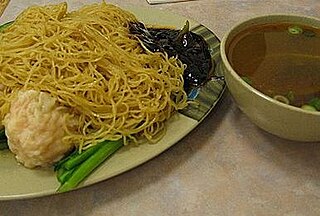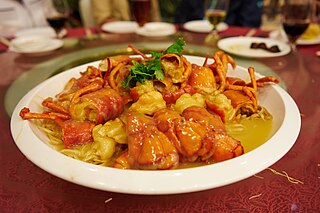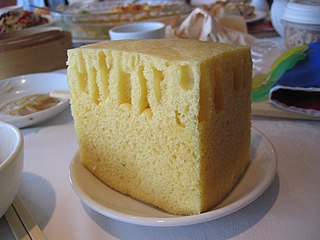
Seitan is a food made from gluten, the main protein of wheat. It is also known as miàn jīn, milgogi, wheat meat, gluten meat, vital wheat gluten or simply gluten. It is made by washing wheat flour dough with water until all the starch granules have been removed, leaving the sticky insoluble gluten as an elastic mass, which is then cooked before being eaten.

Chinese folk art are artistic forms inherited from a regional or ethnic scene in China. Usually there are some variation between provinces. Individual folk arts have a long history, and many traditions are still practiced today. The general definition of folk art incorporates Chinese art forms that are not classified as Chinese fine art.

Malaysian cuisine consists of cooking traditions and practices found in Malaysia, and reflects the multi-ethnic makeup of its population. The vast majority of Malaysia's population can roughly be divided among three major ethnic groups: Malays, Chinese and Indians. The remainder consists of the indigenous peoples of Sabah and Sarawak in Malaysian Borneo, the Orang Asli of Peninsular Malaysia, the Peranakan and Eurasian creole communities, as well as a significant number of foreign workers and expatriates.

A mooncake is a Chinese bakery product traditionally eaten during the Mid-Autumn Festival (中秋節). The festival is about lunar appreciation and Moon watching, and mooncakes are regarded as a delicacy. Mooncakes are offered between friends or on family gatherings while celebrating the festival. The Mid-Autumn Festival is widely regarded as one of the four most important Chinese festivals.

Noodles are an essential ingredient and staple in Chinese cuisine. Chinese noodles vary widely according to the region of production, ingredients, shape or width, and manner of preparation. They are an important part of most regional cuisines within China, and other countries with sizable overseas Chinese populations.

Rangoli is an art form originating in the Indian subcontinent, in which patterns are created on the floor or a tabletop using materials such as powdered lime stone, red ochre, dry rice flour, coloured sand, quartz powder, flower petals, and coloured rocks. It is an everyday practice in Hindu households, however the colours are preferred during festivals and other important celebrations as it is time consuming. Rangoli are usually made during Diwali or Tihar, Onam, Pongal, Sankranthi and other Hindu festivals in the Indian subcontinent, and are most often made during Diwali. Designs are passed from one generation to the next, keeping both the art form and the tradition alive.

Kuih are bite-sized snack or dessert foods commonly found in Southeast Asia. It is a fairly broad term which may include items that would be called cakes, cookies, dumplings, pudding, biscuits, or pastries in English and are usually made from rice or glutinous rice. The term kuih is widely used in Malaysia, Brunei, and Singapore, and kueh or kue is used in Indonesia, to refer to sweet or savoury desserts. Though called by other names, one is likely to find various similar versions of kuih in neighbouring countries, such as Vietnam, Thailand, and Myanmar. For example, the colourful steamed kue lapis and the rich kuih bingka ubi are also available in Myanmar, Thailand, and Vietnam. In the Philippines, kuih are referred to in Tagalog as kakanin.

Singaporean cuisine derived from several ethnic groups which have developed through centuries of political, economic, and social changes of this cosmopolitan city-state.

Banmian or pan mee is a popular Chinese noodle dish, consisting of handmade noodles served in soup. Other types of handmade noodles include youmian, or mee hoon kueh.

Lo mein is a Chinese dish with egg noodles. It often contains vegetables and some type of meat or seafood, usually beef, chicken, pork, or shrimp. It might also be served with wontons although wontons are usually a soup ingredient. It can also be eaten with just vegetables.

Lamian is a type of soft wheat flour Chinese noodle. Lamian is made by twisting, stretching and folding the dough into strands, using the weight of the dough. The length and thickness of the strands depends on the number of times the dough is folded. This unique method of making noodles originated in China. The Songshi Yangsheng Bu, which was written by Song Xu and dates back to 1504, has the earliest description of the method to make lamian.

An animal product is any material derived from the body of an animal. Examples are fat, flesh, blood, milk, eggs, and lesser known products, such as isinglass and rennet.

Bing is a wheat flour-based Chinese food with a flattened or disk-like shape. These foods may resemble the flatbreads, pancakes, pies and unleavened dough foods of non-Chinese cuisines. Many of them are similar to the Indian roti, French crêpes, Salvadoran pupusa, or Mexican tortilla, while others are more similar to cakes and cookies.

Yellow soybean paste is a fermented paste made from yellow soybeans, salt, and water. Yellow soybean paste is produced in China and is used primarily in Beijing cuisine and other cuisines of northern China.

Yi mein is a variety of flat Cantonese egg noodles made from wheat flour. They are known for their golden brown color and chewy characteristics. The slightly chewy and slightly spongy texture of the noodles is due to the soda water used in making the dough, which is then fried and dried into flat patty-like dried bricks.

Oil noodles or cooked noodles is a type of Chinese noodle. It is sometimes used in Cantonese cuisine.

Kue putu or putu bambu is an Indonesian kue. It is made of rice flour called suji and coloured green with pandan leaves, filled with palm sugar, steamed in bamboo tubes, and served with desiccated coconut. This traditional bite-sized snack is commonly found in maritime Southeast Asia, particularly in Java, Indonesia, where it is called putu bumbung. Kue putu is usually sold by street vendors and can be found in traditional markets, along with other kues. Kue putu can also be found in the Netherlands due to its colonial ties with Indonesia.

Hui mian is a Henan-style noodle soup. Lamb bones are cooked with Chinese herbs for at least 5 hours to get a distinct milky white broth. In addition to noodles, the soup can contain kelp shreds, tofu shreds, coriander, quail eggs, and may be garnished with coriander, chili oil, sugar garlic, and minced peppers.

Prima Taste (Simplified Chinese: 百胜厨 Bǎishèngchú, is a Singaporean food and beverage brand managed by Prima Food Pte Ltd, a wholly owned subsidiary of Prima Limited. The brand was designed for Singaporean expatriates living abroad. Its Laksa sauce kits were recommended by Singaporean chef, Janice Wong, as foodie souvenirs to take home during the 2018 North Korea–United States summit.

Malay sponge cake, written as either or and known as ma lai go in Cantonese and ma lai gao in Mandarin, is a popular dessert cake in Guangdong and in Hong Kong. It usually can be seen at a traditional teahouse in Guangdong and Hong Kong. The Malay sponge cake is made up of lard or butter, flour, and eggs, by using bamboo steamer to give puffiness. An entire Malay sponge cake is a huge yellow round cake, but is generally sold as slices in teahouses. There are many ways to make a Malay sponge cake, but in general, the taste should be very soft, sweet and chewy.



















